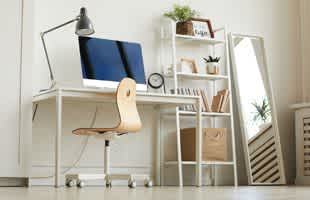Home Office & Work From Home Expenses

In today's digital age it has become quite normal for people to spend at least some of their time working from home, with many businesses offering remote working days as an incentive to attract talent and provide a more flexible workplace for those with children.
While working from home has its benefits, such as getting more sleep, avoiding the chaos of the daily commute and being able to work in your PJ's, it can also hurt your hip pocket if you have to pay for the expenses that your employer would normally cover, such as phone and internet costs, utility bills & additional equipment needed for you to do your job. Happily, many of these expenses can be claimed back at tax time. Read on to learn more.
What can be Claimed as a Hoem Office Expense?
The Australian Taxation Office (ATO) allows you to claim the work-related costs of the following items for the time you were working from home:
- Phone (landline and/or mobile)
- Internet
- Heating/cooling & lighting
- Home office consumables such as stationery and printer ink cartridges
- Cleaning & maintaining your home office area
- Repairing home office equipment and computers
- Value Depreciation of home office furniture and fittings
- Value Depreciation of home office equipment and computers
- Work related items costing less than $300 can be written off in full (no depreciation required).
What Home Offices Expenses are not Tax Deductible?
If you are an employee who is working from home, the following items are not considered eligible home office expenses for tax purposes:
- Rental payments
- Mortgage interest
- Property insurance
- Land taxes
- Rates.
In addition, if you are claiming expenses for your home office as an employee there are no capital gains tax (CGT) implications. On the other hand, if you are running a business out of your home CGT may apply if you are claiming any occupancy expenses such as rent, mortgage interest, etc. If this is the case, you would not be entitled to the full main residence CGT exemption on your home.
The Three Ways you can WFH
Many people may be unaware that the deductions you can claim depend on the type of home office setup you have. The three types outlined by the ATO are:
- You have a dedicated work area. A room such as a study or spare room that is set aside primarily or exclusively for work activities but your home isn't your principal place of business. For example if you work at an office but also work from home once every fortnight.
- You don't have a dedicated work area. Your principal place of business is not at home and you don't have an area or room primarily or exclusively set aside for work, but you do some work at home. An example of this would be doing a few hours of work in the lounge room on the weekend.
- Your home is your main place of business. A business is run from your home and a room is set aside exclusively for business activities.
The table below outlines the home office deductions you may be able to claim if your home is not your main place of business, which would apply to most people who are employees. More information on how tax deductions for business owners operating out of their homes can be found here.

How do I claim my Home Office Expenses?
There are two methods for logging and claiming home office expenses that are accepted by the ATO which are explained in more detail below.
The Diary Method The first is by providing written records/evidence of the expenses, which can include:
- Receipts for items or equipment
- Diary entries of any small expenses ($10 or less) totaling no more than $200
- Diary entries of expenses of any monetary amount that you cannot get receipts for
- Diary entries of running expenses related to working in your home office. The amount of time spent in the room should be recorded & cover a minimum of four weeks. You can also include calculations of how much time was spent using your equipment
- Itemised phone accounts that highlight work-related calls.
Below is an example of diary entries covering a four week period which includes both equipment depreciation and running costs:

The Rate Per Hour Method
The second is known as the ATO rate per hour or 52c per work hour method, and provides a more streamlined process for calculating your deductions. You simply record the amount of hours that you use your home office or at-home work area and then multiply the total time by 52 cents. You are also able to lodge a separate claim for items such as phone bills, internet expenses & equipment depreciation as well.
What are the Pros and Cons of these two Methods?
The dairy method can result in larger one off reductions, especially if you are claiming items under $300 which are eligible for an immediate write-off in full. However, this comes at the disadvantage of far stricter record-keeping requirements.
The rate per hour method's biggest advantage is ease, since you simply apply a fixed rate deduction to your work from home hours without the need for recording minute details. It can also result in greater ongoing deductions assuming that future use and utility costs remain more or less the same.
The COVID-19 Short Cut Method
In response to the global Coronavirus (COVID-19) outbreak, many Australian businesses have transitioned their in-office employees to work from home as a safety precaution. As such, there will likely be a far greater number of people claiming home office and work from home tax deductions for the 2020 financial year. Recognising this, the ATO has implemented a temporary simplified process for calculating your expenses which is based on the rate per hour method.
What are the eligibility requirements?
In order to claim working from expenses using the short cut method, all of the following must apply:
- You must be fulfilling your work-related duties from home and not just carrying out minimal tasks such as periodically checking emails or taking calls
- You must be incurring additional deductible running expenses as a result of working from home.
- You must have spent the money
- The cost must have been directly related earning your salary
- Recorded evidence must be available.
If you have been provided an allowance by your employer to cover some or all of your work from home expenses, you can still claim a deduction provided you declare the allowance amount on your tax return. In addition, You do not have to have a separate or dedicated area of your home set aside for working, such as a private study or office.
You cannot claim a deduction on items or equipment provided by your employer, such as computers, chairs, standing desks etc taken from the business premises or on general household items such as coffee, tea and milk. You are also ineligible to claim for items which have had the cost reimbursed in full to you by your employer.
How does the Short Cut Method work?
It allows you to claim a fixed deduction of 80 cents for each hour that you work from home due to COVID-19 between the periods of 1 March 2020 and 30 June 2020, and covers all the standard deductible running expenses including:
The shortcut method rate covers all deductible running expenses, including:
- Electricity used for lighting, gas, cooling or heating and running electronic items for work-related purposes such as computers and printers
- Depreciation in value and repair of items such as home office furniture and furnishings
- Cleaning and maintenance expenses
- Work-related phone and internet costs, including the value depreciation of the handset
- Consumables such as printer ink cartridges and stationery
- Depreciation value of a computer and laptops.
One important thing to note is that if you claim a deduction for some or all of these running expenses using this method, you cannot claim a further deduction on them using a different method You must also keep a record of the amount of hours you have accrued while working from home due to COVID-19. Eligible records include timesheets, time tracking software logs, diary notes or rosters.
If you opt to use the shortcut method to claim a home office or work from home tax deduction via myGov or a tax agent, remember to include a note stating 'COVID-hourly rate' in your tax return.
As tax time approaches, many people begin to pay more attention to their personal finances. If you've decided to use this period as an excuse to get organised and are currently juggling multiple loans, a debt consolidation loan may be an easy way to condense these into one easy repayment while lowering your overall interest rate.
This page is intended to provide general information only and does not take into account your individual objectives, financial situation or needs.. You should seek independent, professional tax advice before making any decision based on this information. The Australian Taxation Office also has resources available at www.ato.gov.au/Individuals.
SocietyOne is not a registered tax (financial) adviser under the Tax Agent Services Act 2009 and you should seek tax advice from a registered tax agent or a registered tax (financial) adviser if you intend to rely on this information to satisfy the liabilities or obligations or claim entitlements that arise, or could arise, under a taxation law.
You may also like
News, tips and offers straight to your inbox.


